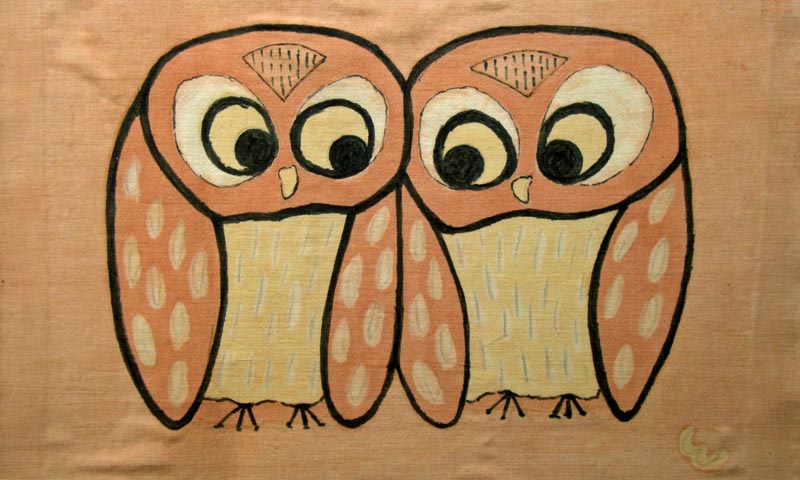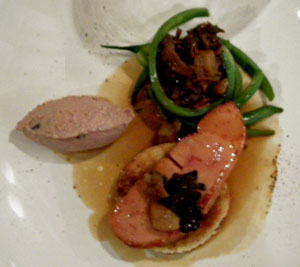Most Recent -
Next -
Previous -
Top -
Page 1 -
Photos -
Index -
Topics -
Jazclass Links
Monday March 24, 2008
(diary, bio)
I go to my lockup to store a few things before I leave and get some more copies
of my Scales & Arpeggios book to take with me. To my delight I find some more
visual material for my Blog, including three lovely batik paintings by my mother.
I have been looking for them for some time.
 My mother Else was a very versatile artist and worked in a wide range of
media over the years. During the first few years at Martinshof (1942-44),
probably inspired and prompted by the surrounding corn fields, she worked with
straw. Else was an expert at plaiting straw, a delightful skill common
amongst many women in Germany and Scandinavia. More often than not the bath in
our bathroom was filled with bunches of straw soaking in cold water for a few
days. She made animals etc. from plaited straw but also rather figurines of
un plaited straw material.
My mother Else was a very versatile artist and worked in a wide range of
media over the years. During the first few years at Martinshof (1942-44),
probably inspired and prompted by the surrounding corn fields, she worked with
straw. Else was an expert at plaiting straw, a delightful skill common
amongst many women in Germany and Scandinavia. More often than not the bath in
our bathroom was filled with bunches of straw soaking in cold water for a few
days. She made animals etc. from plaited straw but also rather figurines of
un plaited straw material.
Later, during her time in the post WW2 concentration camps she made figurines
from scraps of hessian. She continued with this back home at Martinshof after her
release. When I was a teenager Else got into batik painting of
which I have included three items in my Blog Photo Gallery.
When we were in Australia she got into
patchwork banners. She used to send several of them to us but I have no
idea where they have gone after all these years. I believe Wivica still has some
at her home and if so will photograph those too.
 When my mother started visiting us in Australia, first in
Kalgoorlie (in 1970), then later with my father in Yonki and Canberra, she at
once got together with Antien into making pottery. During these
stays she learned as much as she could and soon was making things back home in
Holland. By that time Else had retired from the Martinshof business and
had a small studio at home in the garden where she was daily visited by a few
children who loved making things together with my mother.
When my mother started visiting us in Australia, first in
Kalgoorlie (in 1970), then later with my father in Yonki and Canberra, she at
once got together with Antien into making pottery. During these
stays she learned as much as she could and soon was making things back home in
Holland. By that time Else had retired from the Martinshof business and
had a small studio at home in the garden where she was daily visited by a few
children who loved making things together with my mother.
After my father's death she moved to a townhouse in the village of Gorssel,
opposite the new premises of the Martinshof business I had sold by that time. We
converted the garage into a lovely studio complete with kiln.
Unfortunately in her final five years my mother suffered a mental setback,
requiring my sister Wivica to look after her. This prevented her from
making complicated things. Much frustrated she resorted to the only thing she
was still capable of, knitting simple scarves in a variety of colours. As
mentioned earlier in this Blog, after her
funeral in 1989 we gave everybody one of her scarves, mine is green and blue. I
still have got it.
PS
Wednesday I will start driving up North to Darwin, a distance of 3,500 kms. I promissed myself to take it easy this time and take about 5 days to get there. My Blog entries may therefore not be quite as regular over the next week or so, we will see.
Most Recent -
Next -
Previous -
Top -
Page 1 -
Photos -
Index -
Topics -
Jazclass Links
Tuesday March 25, 2008
(diary, food)
 I start packing up and say my good byes at the Surf Club.
I start packing up and say my good byes at the Surf Club.
I have not visited
Pru at The Outrigger men shop in Mooloolaba for a while so decide
to go and check it out before leaving. I usually buy there something every year.
They have a great woolen sweater and dark blue Gazman tencil jeans, just right
for the Black Forest, where they had 15 cm (6 inches) snow this weekend.
We have booked for dinner at the The French Room Restaurant in Woombye tonight (07 5442 1511). Babette is shouting me a farewell meal
there. She manages to get home from work relatively early and brings some great
news, so we are in good spirits as we arrive at the restaurant.
 Jo the maitre d' welcomes us at the door and I see
Erik van Alphen the chef already busy in the kitchen. All week we have
been looking forward to the entree we already decided on, paté de fois
gras with truffles. Well we are not disappointed, they prove to be absolutely
magic. As main course I have an entrecote with a delicious red wine sauce with
wild mushrooms. The sauce is so good I ask for some bread to mop up my plate.
Yes, of course, real French bread imported from France frozen at minus
80° Celsius !
Jo the maitre d' welcomes us at the door and I see
Erik van Alphen the chef already busy in the kitchen. All week we have
been looking forward to the entree we already decided on, paté de fois
gras with truffles. Well we are not disappointed, they prove to be absolutely
magic. As main course I have an entrecote with a delicious red wine sauce with
wild mushrooms. The sauce is so good I ask for some bread to mop up my plate.
Yes, of course, real French bread imported from France frozen at minus
80° Celsius !
I now find out why the French bread we buy in Australia
never ever tastes as it should. The Australian flower, Erik tells us, is just not
suitable to make this type of bread. And boy, can you taste the difference !!
After the meal Erik joins us for a glass of wine and a chat. He has settled
down here after 38 years in the business, a Michelin 5 Star chef who worked with
top chefs in Europe including Paul Beaucouse. I am not an expert on food,
but this was really good tonight. We leave home very satisfied customers.
Early to bed tonight. I am on the road tomorrow.
Email thefrenchroom@bigpond.com
Comments -
Most Recent -
Next Page -
Previous -
Top -
Page 1 -
Photos -
Index -
Topics -
Jazclass Links
Copyright © 2008 Michael Furstner